Bedlasky
International Hazard
    
Posts: 1219
Registered: 15-4-2019
Location: Period 5, group 6
Member Is Offline
Mood: Volatile
|
|
Molybdenum complex chemistry
Hi.
I publish new article about molybdenum complex chemistry in czech and also in english.
This is my longest and the most complex article on my website right now (and it's very unlikely that I make something longer). Molybdenum complex
chemistry is very spectacular, but also very complicated (especially complex chemistry of hexavalent molybdenum). It take lots of experimenting and
research and I am still quite unsure about some things. I can split it in to shorter articles, but I like the idea that all these complexes are
described in one article and one can compare them to each other.
After today work with correction and embedding an article on the web (which takes a few hours) I have full head off molybdenum, I can't hear that word
again for some time  . I'll return to molybdenum complex chemistry once again in
future - this time in synthesis section,where I describe synthesis of various metal heteropolymolybdates and molybdates. But this is a distant future . I'll return to molybdenum complex chemistry once again in
future - this time in synthesis section,where I describe synthesis of various metal heteropolymolybdates and molybdates. But this is a distant future
 . But I can post in to this thread some photos of finished products in next few
days - there is an interesting difference in the colour of molybdate/heteropolymolybdate of the same metal. I made Cr(III), Mn(II), Co(II) and Ni(II)
salts, but I want to try at least Cu(II) and V(IV) salts in future (maybe also Fe(III) and V(V) but about them I am not sure right know. All these
compounds are nice for collection, but don't have any interesting uses in home lab). . But I can post in to this thread some photos of finished products in next few
days - there is an interesting difference in the colour of molybdate/heteropolymolybdate of the same metal. I made Cr(III), Mn(II), Co(II) and Ni(II)
salts, but I want to try at least Cu(II) and V(IV) salts in future (maybe also Fe(III) and V(V) but about them I am not sure right know. All these
compounds are nice for collection, but don't have any interesting uses in home lab).
Molybdenum is really chameleon among the elements - just look at photos in article  . I plan make rainbow picture from photos of molybdenum compounds from my various redox/complex/precipitate experiments . I plan make rainbow picture from photos of molybdenum compounds from my various redox/complex/precipitate experiments  . .
[Edited on 27-8-2020 by Bedlasky]
|
|
|
B(a)P
International Hazard
    
Posts: 1114
Registered: 29-9-2019
Member Is Offline
Mood: Festive
|
|
Wow Bedlasky, that is some amazing work! I have a few 100 g of MoO3 and have never had a use for it. You have inspired me to try some of what you have
published.
Thank you for taking the time to write that up and share it with the amateur community!
|
|
|
teodor
National Hazard
   
Posts: 872
Registered: 28-6-2019
Location: Heerenveen
Member Is Offline
|
|
I was waiting for this publication. You made a really monumental job. Now I can use it as a reference.
Is there any thiosulfate complexes for Mo?
As per your experience, could Mo chemistry be close to Vanadium chemistry or these elements are completely different beasts?
|
|
|
Bedlasky
International Hazard
    
Posts: 1219
Registered: 15-4-2019
Location: Period 5, group 6
Member Is Offline
Mood: Volatile
|
|
Quote: Originally posted by B(a)P  | Wow Bedlasky, that is some amazing work! I have a few 100 g of MoO3 and have never had a use for it. You have inspired me to try some of what you have
published.
Thank you for taking the time to write that up and share it with the amateur community! |
Thank you very much  . .
Quote: Originally posted by teodor  | I was waiting for this publication. You made a really monumental job. Now I can use it as a reference.
Is there any thiosulfate complexes for Mo?
As per your experience, could Mo chemistry be close to Vanadium chemistry or these elements are completely different beasts? |
I don't know how much are molybdenum and vanadium chemistry similar. I don't have chemistry of vanadium as much researched as the chemistry of
molybdenum. But tungsten have similar complex chemistry as molybdenum (I'll do some experiments with it in future - I have some sodium tungstate). But
redox chemistry of Mo/W is quite different. Mo have very complex aqueous redox chemistry, but W can be reduced only from tungstate in to tungsten blue
(even nascent hydrogen can reduce it only in to tungsten blue). But maybe electrolytic reduction can be used for reduction in to V oxidation state.
Thiosulfate reduce molybdate in to two different products depending on concentration of acid. In 10% H2SO4 molybdenum blue is formed. But in 20% H2SO4
if you use excess of thiosulfate red solution is formed (probably some kind of molybdenum bronze).
I plan to write few other articles about molybdenum chemistry:
1. Molybdenum redox chemistry (different than first one when I used only nascent hydrogen as reductant. In this I use multiple reducing agents like
thiosulfate, TiCl3, SnCl2, VSO4 etc. And I also show some oxidations from lower oxidation states.)
2. Insoluble molybdenum compounds
3. Dissolving metalic molybdenum
And I also plan articles about synthesis of molybdenum compounds. For now I plan only metal molybdates/heteropolymolybdates, but maybe I write some
other synthesis (for example phosphomolybdates and silicomolybdates are quite easy to make).
[Edited on 1-9-2020 by Bedlasky]
|
|
|
teodor
National Hazard
   
Posts: 872
Registered: 28-6-2019
Location: Heerenveen
Member Is Offline
|
|
I don't mean thiosulfate as reducing agent but as a complex forming agent.
I would be interested in chemistry which involves SnCl2 and VSO4.
|
|
|
Bedlasky
International Hazard
    
Posts: 1219
Registered: 15-4-2019
Location: Period 5, group 6
Member Is Offline
Mood: Volatile
|
|
Quote: Originally posted by teodor  | I don't mean thiosulfate as reducing agent but as a complex forming agent.
I would be interested in chemistry which involves SnCl2 and VSO4. |
But thiosulfate acts as reducing agent, not as complexing (if it acts as complexing agent, it will be some unstable transition state, but I never read
about it).
SnCl2 reduce Mo from VI to V oxidation state. I suppose that VSO4 do the same. Btw. Sn2+ forms firstly unstable heteropolymolybdate complex, which is
further reduced (Sb3+ forms similar complex).
|
|
|
teodor
National Hazard
   
Posts: 872
Registered: 28-6-2019
Location: Heerenveen
Member Is Offline
|
|
I found some study of thiosulfate-Mo complexes in this article: https://doi.org/10.1134/S1070328408090066
It is not easy topic and I would not try it by myself yet - Mo is VERY polymorphic for me both in valency and in polymerisation of its acids.
But I have some interest to thiosulfate complexes exactly because the complex can change with time - you say reducing but also it could be a slow
source of S2- ions.
As for general information about Mo complexes, I red in the book "Elementary coordination chemistry" Mark M. Jones, 1964 (the old one but it is my
primary reference just because I don't have a better one):
"Both molibdate and tungstate undergo reactions with polyhydroxy organic compounds such as tartaric, malic, and citric acids. In some respects, these
reactions are similar to the corresponding reactions of borate, though they have not been as thoroughly investigated"
[Edited on 1-9-2020 by teodor]
|
|
|
teodor
National Hazard
   
Posts: 872
Registered: 28-6-2019
Location: Heerenveen
Member Is Offline
|
|
By the way, I am experimenting now studying conditions of KSCN decomposition with Zn (HCN + H2S), just a thought - which experiments we can do with
KSCN + Mo + Zn just to fix (with colour change) SCN- anion breakage?
|
|
|
Bedlasky
International Hazard
    
Posts: 1219
Registered: 15-4-2019
Location: Period 5, group 6
Member Is Offline
Mood: Volatile
|
|
That's interesting Teodor. Probably best slow source of sulfide is thioacetamide, Mo-thiosulfate complex seems to me impractical. I don't have access
to this article, but from my experience redox reaction between molybdate and thiosulfate is really fast (at least in acidic solution). Vibzzlab's synthesis of ammonium tetrathiomolybdate, this can be easily prepared and it release sulfide ions in water.
Complexes with polyhydroxycompounds sounds great. I already plan article about complexes of copper and borate with polyhydroxycompounds, so I
definitely try also molybdate.
I once made a mistake and try to reduce [MoO(NCS)5]2- complex by zinc and I smell some H2S. Then I realized that some HCN can be created as well.
Solution changed colour to green. I found this reaction latter in this book.
Products of reduction are: H2S, CS2, NH3, CH3NH2 etc. I believe that some HCN also forms.
Interesting is that distilling thiocyanate with Al and HCl leads to quantitative reduction in to H2S, C and NH3.
I prepare isothiocyanate complexes of molybdenum in this way:
1. Reduction of molybdate in to desered oxidation state by nascent hydrogen
2. After complete reaction I add KSCN in to solution
If you do it by this way, there isn't reduction of KSCN at all. I described this way also in article.
Mo(V)-NCS complexes can be made also with other strong reductants. I personally use TiCl3 or SnCl2.
|
|
|
teodor
National Hazard
   
Posts: 872
Registered: 28-6-2019
Location: Heerenveen
Member Is Offline
|
|
Quote: Originally posted by Bedlasky  |
I once made a mistake and try to reduce [MoO(NCS)5]2- complex by zinc and I smell some H2S. Then I realized that some HCN can be created as well.
Solution changed colour to green. I found this reaction latter in this book.
Products of reduction are: H2S, CS2, NH3, CH3NH2 etc. I believe that some HCN also forms.
|
My idea was to bind CN- to some complex to detect qualitative (better say: rough quantitative) in which conditions it forms. Because this reduction
requires acidic condition I unable to precipitate it as an insoluble cyanide and need just something else to approx detect amount which is formed.
So, I think I need some metal which forms a complex with CN- but not with CNS-, if there is such a beast exists.
[Edited on 2-9-2020 by teodor]
[Edited on 2-9-2020 by teodor]
|
|
|
Bedlasky
International Hazard
    
Posts: 1219
Registered: 15-4-2019
Location: Period 5, group 6
Member Is Offline
Mood: Volatile
|
|
If you want to bind cyanide to some metal, just use KCN or NaCN.
Btw. molybdenum cyanide complexes are quite stable even in highly acidic solution. Mo have great tendency to bind with cyanide. But be careful. Even
if I know that these complexes are stable, I still feel scared to add cyanide in to acidic solution.
Cyanide and fluoride complexes are most stable. So transition metals will prefer cyanide than thiocyanate. If I know, Ni doesn't form thiocyanate
complexes in aqueous solution (but I am not certanly sure).
|
|
|
teodor
National Hazard
   
Posts: 872
Registered: 28-6-2019
Location: Heerenveen
Member Is Offline
|
|
So, I will put Ni CN and CNS complexes on my list of future experiments.
About working with HCN, keeping the flask/tube in ice-cold water under really good ventilation (one of the last upgrade I did for my laboratory) is
looking quite safe for me, but I would prefer to have a colorimetric method (instead of using my nose) to detect its presence as well as a method of
fast binding CN- in acidic conditions. According to your experiments Mo complex sounds promising for this.
[Edited on 2-9-2020 by teodor]
[Edited on 2-9-2020 by teodor]
|
|
|
Bedlasky
International Hazard
    
Posts: 1219
Registered: 15-4-2019
Location: Period 5, group 6
Member Is Offline
Mood: Volatile
|
|
Here are some photos of metal molybdates/heteropolymolybdates which I made.
(NH4)3H6[Cr(MoO4)6] - left
Cr2(MoO4)3 - right
![(NH4)3H6[Cr(MoO4)6]-Cr2(MoO4)3 - kopie.JPG - 646kB](http://www.sciencemadness.org/talk/files.php?pid=644168&aid=83108)
(NH4)4H6[Mn(MoO4)6] - left
MnMoO4 - right
![(NH4)4H6[Mn(MoO4)6]-MnMoO4 - kopie.jpg - 598kB](http://www.sciencemadness.org/talk/files.php?pid=644168&aid=83110)
(NH4)4H6[Co(MoO4)6] - left
CoMoO4 - right (in reality looks more violet, see photo below)
![(NH4)4H6[Co(MoO4)6]-CoMoO4 - kopie.JPG - 727kB](http://www.sciencemadness.org/talk/files.php?pid=644168&aid=83112)
CoMoO4 - this photo captures a more realistic colour
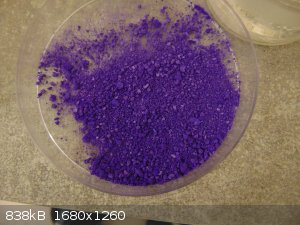
(NH4)4H6[Ni(MoO4)6] - right
NiMoO4 - left
![(NH4)4H6[Ni(MoO4)6]-NiMoO4 - kopie.JPG - 676kB](http://www.sciencemadness.org/talk/files.php?pid=644168&aid=83116)
|
|
|
MidLifeChemist
Hazard to Others
  
Posts: 192
Registered: 4-7-2019
Location: West Coast USA
Member Is Offline
Mood: precipitatory
|
|
Thanks so much for posting this! I ordered some Sodium Molybdate and I look forward to trying some reactions myself.
|
|
|
Bedlasky
International Hazard
    
Posts: 1219
Registered: 15-4-2019
Location: Period 5, group 6
Member Is Offline
Mood: Volatile
|
|
Hi.
For the once which are interested in synthesis of some of beautifuly coloured molybdenum complexes I read this article about synthesis various metal
molybdates and heteropolymolybdates in czech/english.
|
|
|
Boffis
International Hazard
    
Posts: 1836
Registered: 1-5-2011
Member Is Offline
Mood: No Mood
|
|
Hi Bedlasky, nice work but I have a question. How do you know that form example in the cobalt molybdate complex the cobalt is part of the Keggan
heteropolymolybdate ion rather than as a counter ion?
|
|
|
Bedlasky
International Hazard
    
Posts: 1219
Registered: 15-4-2019
Location: Period 5, group 6
Member Is Offline
Mood: Volatile
|
|
Boffis: Look at this.
|
|
|
MidLifeChemist
Hazard to Others
  
Posts: 192
Registered: 4-7-2019
Location: West Coast USA
Member Is Offline
Mood: precipitatory
|
|
380 pages of Molybdenum reactions.... wow
|
|
|
Lion850
National Hazard
   
Posts: 514
Registered: 7-10-2019
Location: Australia
Member Is Offline
Mood: Great
|
|
Bedlasky I hope you don't mind me tacking on to your thread to post my molybdate colors 
The plan was to make sodium molybdate by reaction between MoO3 and NaOH and then metal molybdates by double displacement reaction between the sodium
molybdate and a metal nitrate salt. I mixed NaOH and MoO3 as per stoichiometric amounts to obtain Na2MoO4 but the resultant clear solution was still
very alkaline pH ~14, and when tested with copper nitrate first gave blue copper hydroxide before green copper molybdate. I then kept adding MoO3 to
the NaOH solution until the pH was 6-7 and a test with copper nitrate did not show any blue salt forming.
To get to this 'neutral' solution of sodium molybdate I had to used 6g NaOH and 16g MoO3. Even taking into account that my MoO3 is only minimum 90%
purity (with most of the rest being ammonium molybdate according to the label) it still seemed too much MoO3. But the resultant clear solution seemed
to work well for making the metal molybdates. In all cases below the ppt was recovered by vacuum filtering, washed in the filter with water, and dried
on a steam bath, usually for 4 to 6 hours.
COPPER:
The Na2MoO4 solution was added to 21.5g of Cu(NO3)2.6H2O dissolved in 100g water. A green suspension formed. The solution was then heated to boil, and
the suspension turned yellow. 13g of "flaxen yellow" product was recovered.
The experiment was repeated with the same amounts of reagents but this time the solution was just stirred for 10 minutes without heating it up. This
time a green product was recovered. The green colored remained on the steam bath, so I am not sure whether the color difference is due to hydration or
something else. 16g of green product was recovered:
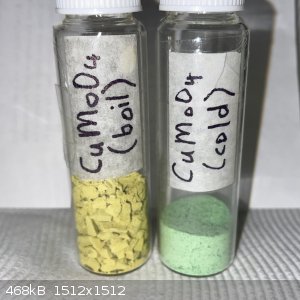
COBALT:
The sodium molybdate solution was added to Co(NO3)2.6H2O in 100ml water. The result was 16.6g of purple product:
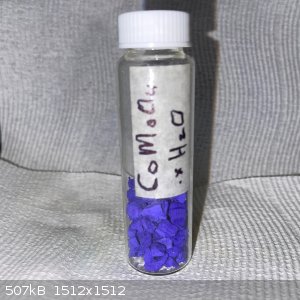
CHROMIUM:
The sodium molybdate solution was added to 19.4g Cr(NO3)3.9H2O in 100ml water. 24.3g of green product was recovered:
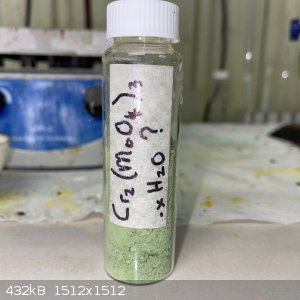
MANGANESE:
The sodium molybdate solution was added to 21g of Mn(NO3)2.4H2O in 100g water. The cream colored (extremely pale yellow) was quite lumpy and jammed
the stir bar, I added another 50ml water and stirred for 20 minutes. 19.5g of product was obtained. On the phone camera it basically looks creamy
white, but there is just a hint of yellow:
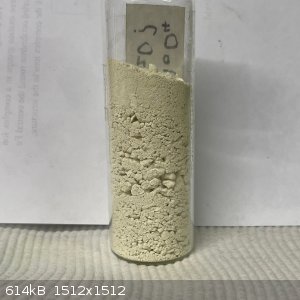
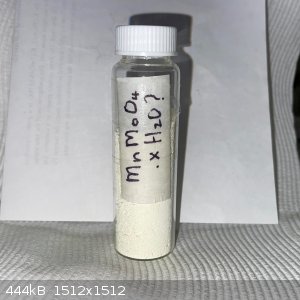
IRON:
The sodium molybdate solution was added to 19.6g Fe(NO3)3.9H2O in 100g water. It formed a thick dark peach colored suspension. I added another 80ml
water and stirred for some 30 minutes. This solution was also the most difficult to filter (but still much easier than iron hydroxide). The color
darkened to dark brown on the steam bath. 22.7g product was recovered:
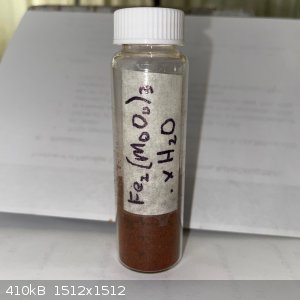
NICKEL:
The sodium molybdate solution was added to 21.2g Ni(NO3)2.6H2O in 100g water. A light green suspension formed:
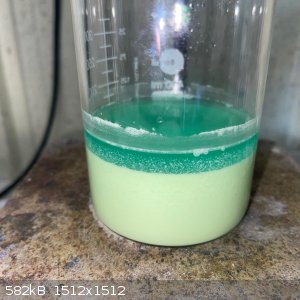
I heated it to boil to see if the color changed. It did indeed shift towards yellow, and interestingly the supernatant solution lost most of its green
color during the boiling. Does this indicate that another reaction took place when boiled? 18g of "lemon yellow" product was recovered.
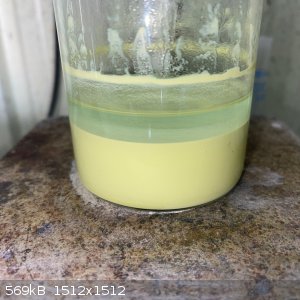
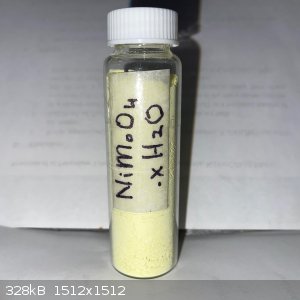
Family photo:
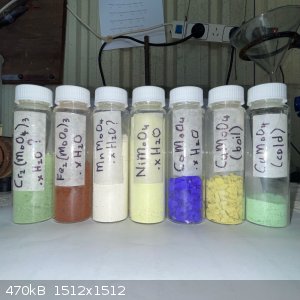
|
|
|
vano
National Hazard
   
Posts: 661
Registered: 22-3-2019
Location: Georgia
Member Is Offline
|
|
Bedlasky how did you make (NH4)4H6[Mn(MoO4)6]?
|
|
|
Bedlasky
International Hazard
    
Posts: 1219
Registered: 15-4-2019
Location: Period 5, group 6
Member Is Offline
Mood: Volatile
|
|
Simply by mixing saturated solutions of ammonium heptamolybdate and manganese chloride (heptamolybdate in excess). Solid precipitate from the
solution. I put it in to the fridge to crush out even more solid. Similarly for other heteropolymolybdates. Cobalt complex is quite soluble, it must
be evaporate down to get crystals.
[Edited on 7-7-2022 by Bedlasky]
|
|
|
vano
National Hazard
   
Posts: 661
Registered: 22-3-2019
Location: Georgia
Member Is Offline
|
|
Quote: Originally posted by Bedlasky  | Simply by mixing saturated solutions of ammonium heptamolybdate and manganese chloride (heptamolybdate in excess). Solid precipitate from the
solution. I put it in to the fridge to crush out even more solid. Similarly for other heteropolymolybdates. Cobalt complex is quite soluble, it must
be evaporate down to get crystals.
[Edited on 7-7-2022 by Bedlasky] |
thanks!
|
|
|
Bedlasky
International Hazard
    
Posts: 1219
Registered: 15-4-2019
Location: Period 5, group 6
Member Is Offline
Mood: Volatile
|
|
Because I had in a last month few requests about my molybdenum articles, I decided to repost them here as PDF's. I also have one unfinished article
about tungsten chemistry, only thing which is missing is translation of explanation part. But I post it here anyway, because I probably won't
bothering finished it in the near future. I am probably only person on SM who examined these two elements in such a extent, so I hope that these
articles help others with their research and experiments.
Sorry that I haven't be here lately, I didn't do much chemistry (and I doubt that I ever will again). Probably most of you noticed that I deleted my
website, but if anyone will need some of my articles, just let me know. I do small experiment right know with crystallizing Co complex with bidentate
nitrato ligand. If I will be successful, I'll start a thread about it.
[Edited on 17-8-2022 by Bedlasky]
Attachment: Tungsten complex and redox chemistry.pdf (315kB)
This file has been downloaded 220 times
Attachment: Synthesis of heteropolymolybdates.pdf (120kB)
This file has been downloaded 216 times
Attachment: Molybdenum - chameleon among elements.pdf (436kB)
This file has been downloaded 259 times
|
|
|
Bedlasky
International Hazard
    
Posts: 1219
Registered: 15-4-2019
Location: Period 5, group 6
Member Is Offline
Mood: Volatile
|
|
Hi.
I recently suggested sequence of colorful reactions based on Mo(V) complex chemistry. So I tried it and made a video of the reaction.
https://www.sciencemadness.org/whisper/viewthread.php?tid=15...
I dissolved small amount of K2[MoOBr5] in cca 7 ml 48% HBr. Resulting solution was brown. Then I added cca 7 ml of 36% HCl, solution turned green.
Then I added cca 10 ml of water, solution turned brown. And finally I added few drops of KSCN solution, solution turned very dark red. I tried to make
another color change using fluoride but it didn't work. I chose 25 ml beaker which wasn't exactly ideal, better option would be 50 ml beaker, so you
can add little bit more water in the third step. If I will do it again I would choose this ratio:
10 ml 48% HBr
10 ml 36% HCl
20 ml H2O
5 ml 10% KSCN
Explanation is pretty simple, 1. Br- is displaced by Cl-, 2. Cl- is partially displaced by H2O, 4. Remaining Cl- is displaced by NCS-. Green complex
is [MoOCl5]2-, brown is mixture of [Mo2O4L6]n+ and [Mo2O3L8]x+, L is ligand, in this case Cl and H2O in various ratio. Dark red is mixture with the
same species, but all Cl atoms are displaced with NCS.
https://youtu.be/ZEzFCto0ZBA
I posted preparation of K2[MoOBr5] on this forum. But it is not necessary to make it for this experiment. Just dissolve small amount of MoO3 or some
molybdate in 48% HBr and boil it for 10-15 minutes or so. Or if you don't want to boil the mixture, add ascorbic acid as reducing agent.
[Edited on 25-12-2022 by Bedlasky]
|
|
|
Fery
National Hazard
   
Posts: 990
Registered: 27-8-2019
Location: Czechoslovakia
Member Is Offline
|
|
Hi Bedlasky, thank you for sharing the video!!! Beautiful colors! Well done! Subscribed to the channel.
|
|
|